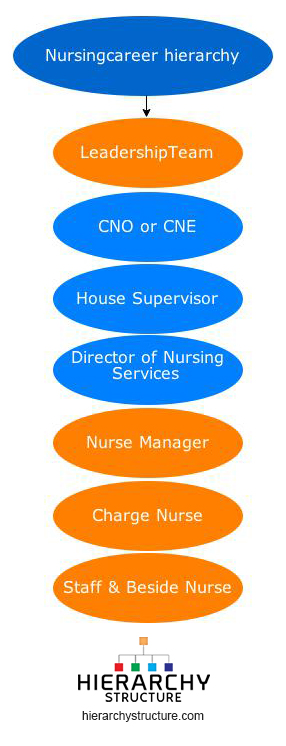Like in any other professional career, the health care field also has got its hierarchy of professionals ranked in diverse levels. A person’s nursing career is graded based on their educational qualification and licensure along with the years of experience. In the nursing career hierarchy, progressive and experienced nurses will be posted in leadership positions, whereas beginners will be recruited as an LPN or aide to start from ground level.
Given below is a detailed structure of the Nursing career hierarchy:
 Leadership Team
Leadership Team
- CNO or CNE
The top most position in the nursing career job hierarchy is named as Chief Nursing Officer (CNO) or Chief Nursing Executive (CNE). The nurse who is holding this chief position usually works directly under the CEO or MD of the hospital or the agency. The CNOs or CNEs generally possess a master’s degree or higher in nursing and will be responsible for all the nursing facilities delivered across the health care unit or hospital.
- House Supervisor
There will be various nurses holding the position of house supervisor and they handle the responsibility of staffing even on weekends, nights, holidays and so on. They are also responsible for emergencies, on-call systems and inter-facility transfers. This position typically reports to the CNO, and it doesn’t require high educational qualification, instead it calls for experience in clinical skills and leadership qualities.
- Director of Nursing services
The DONS or Director of nursing services is also called the director of patient care services (DOPCS), and a person in this position performs administrative jobs more than nursing ones. This role requires a master’s degree with specialisation and a director is in charge of clinical operations pertaining to a department and reports to the DNO.
Nurse Manager
The manager or nursing supervisor or the head nurse has the responsibility of various units including the medical care of the patients and the running of the units. The nurse manager needs to interact with the doctors and other non-nursing staff to arrange care and support the patients. She holds responsibility of hiring new recruits as well as scheduling teams.
Charge Nurse
The nurse in-charge is responsible for the general daily patient care of a specific unit in a specific shift. The charge nurse is also accountable for compliance with all procedures, policies and assignments along with coordinating recruitment with house supervisors to shield call-ins and arrange temporary assignments as required. Multiple nurses rotate the responsibility of charge nurse as per shift and she usually reports to the nurse manager. As for qualification, a BSN is required along with sound leadership and clinical skills.
Staff and Bedside Nurse
The staff and bedside nurse is directly responsible for personal patient care and generally reports to the charge nurse. The RN along with a staff nurse may be recruited as team leader to a set of nurses to manage care to a fixed assignment. The nursing aides and LPNs offer bedside patient care as given and controlled by the team leader or the charge nurse or other RN.
